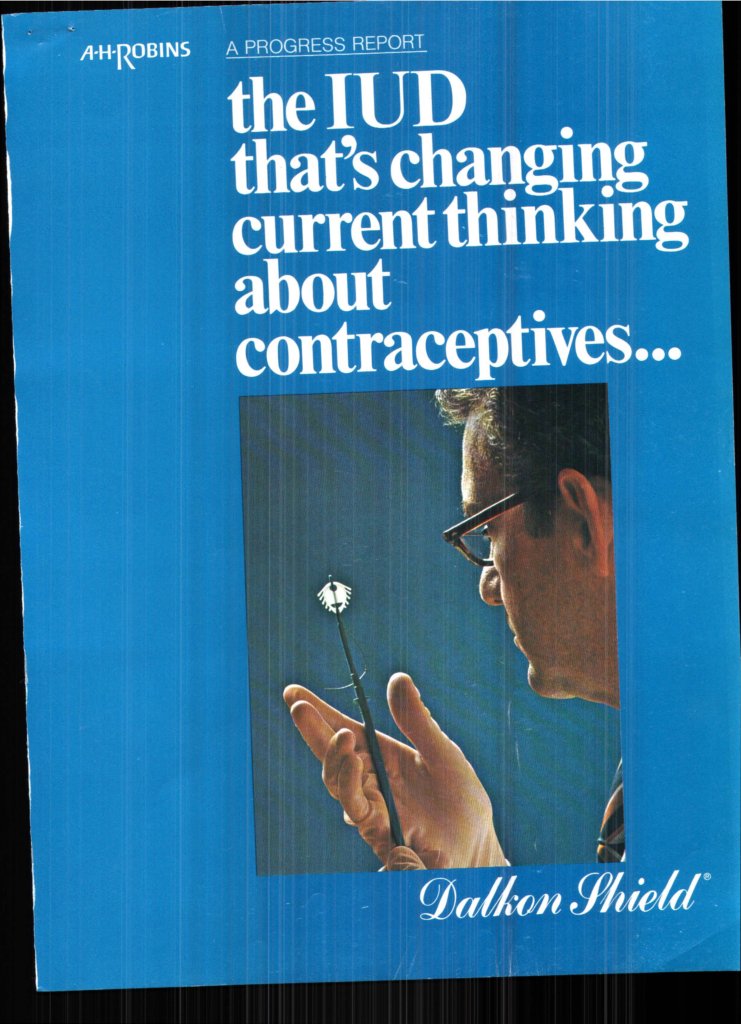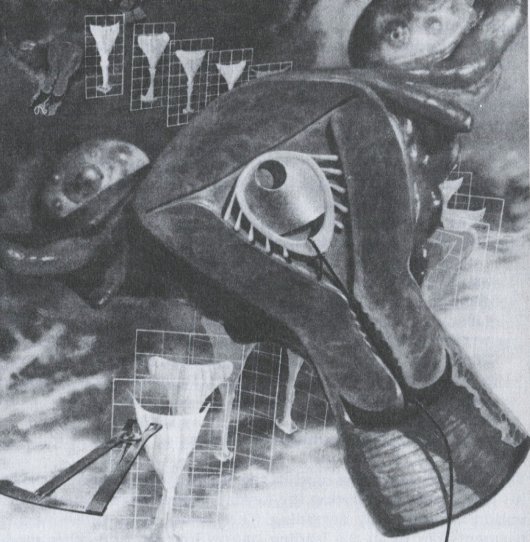“Instruments of Death, of Mutilation, of Disease”: the Lessons of the Dalkon Shield
In 1983, Minnesota Judge Miles Lord described the Dalkon Shield IUDs as “instruments of death, of mutilation, of disease.” The Dalkon Shield was at the center of a heated lawsuit between the corporation A.H. Robins and 21 women who were suing the contraceptive manufacturer for compensation and punitive damages. Judge Lord was not the only judge to see a case involving harm caused by the Dalkon Shield. Over the course of five years, the Shield fell from being regarded as the top contraceptive choice for people with uteruses to being faced with public ridicule and legal recourse. I only learned about the Dalkon Shield recently, but when I asked my mom, aunt, and grandmas about it, they all remember it well: the promise, the harm, the lawsuits, and the misogynist legacy.
The Dalkon Shield was a popular IUD option in the late 1960s following public concern over the then extensive side effects of the pill (oral contraceptive). In response to the backlash against the side effects, corporations and doctors (comprised nearly exclusively of cis men) capitalized on the need for contraceptive alternatives. The Dalkon Shield was unlike other available contraceptives because it acknowledged the pain associated with its competitors and offered a solution.
Dr. Hugh Davis invented the Dalkon Shield in 1968 and later sold the rights to A.H. Robins, the Chapstick manufacturer, in 1970. The Shield appealed to users because of its extremely high efficacy (marketed as 98.9% effective), its lack of side effects, and its convenience (compared to the daily pill, the Shield was inserted once like contemporary IUDs and was said to effectively prevent pregnancy for a number of years). Given the gap it was addressing in the contraceptive market as well as its revolutionary promises, the Dalkon Shield immediately became a successful product for doctors and patients. Many began choosing the Shield at their doctors’ recommendations and had it inserted -- around 59% of all IUDs inserted in 1972 were Dalkon Shields.
People lived with the Dalkon Shield for years with little notice or discomfort, though in many cases irreparable internal harm was being done by the tiny device. Testimonials reveal that in some cases the IUD scarred uteruses, it dislodged & floated to abdomens, and it introduced bacteria to sterile uteruses. Furthermore, the device did not deliver on the efficacy it boasted in advertisements, leading to unintended pregnancies for between 3.1-10% of users -- the exact percentage is disputed across tests. As Dr. Davis and A.H. Robins made more and more money, Shield users had their reproductive health degraded, sometimes to fatal ends.
A confluence of conditions allowed the widespread fraud and harm of the Dalkon Shield to persist. One key element was the lack of oversight by the FDA (Food and Drug Administration) which did not regulate medical devices at the time, only medicine that was orally consumed. Thus, the Dalkon Shield was able to function more like a consumer product than a medical device, with no governmental testing or monitoring. Patients reasonably assumed that their doctors had directly or indirectly tested the safety and efficacy of the contraceptive they were inserting. Yet, the Dalkon Shield’s success was a result of its marketing alone, with no correlation to its performance as a contraceptive. In truth, doctors and patients had little understanding of what was being placed inside of uteruses across the country and the world.
The most substantive cause of the Dalkon Shield’s harm was the corporate and personal greed of A.H. Robins and Dr. Davis, respectively. Concern over profit margins, rather than the health and wellbeing of Shield users, drove decision-making in manufacturing and marketing. In both design and production, the Dalkon Shield invited infection. The design included a “tail” that had unsealed ends and a sheathed middle that was often found to contain holes in it. Thus, the “tail” reaching down through the uterus could introduce bacteria from the outside world into the sterile uterus causing pelvic inflammatory disease.
The production of the Shield was carried out in Robins’ Chapstick factory without medical supervision and performed by workers with no training in contraceptives or medical devices. Employees responsible for quality control were not given specific training regarding standards of safety with respect to the Shield. Even so, a quality control employee brought his concerns about the tails to a manager who promptly shut him down. Each aspect of the corporate negligence was a result of a pursuit of profit which came at the cost of lives and health for people with uteruses.
The Dalkon Shield harkens back to an era when the health and wellbeing of people with uteruses (erroneously typed as exclusively women) was a secondary concern to profits in the contraceptive industry (Oh wait! We still live in that era!). The rhetoric surrounding birth control emphasized the misogynistic and transphobic notion that women, as the supposed only group capable of becoming pregnant, were expected to accept myriad side effects to the detriment of their physical, emotional, and mental wellbeing - even their lives. An estimated 18-20 people died from complications related to the Dalkon Shield. Reproductive health, and the wellbeing of people with uteruses specifically, was dismissed to catastrophic degrees.
Yet, the contemporary effects of the Dalkon Shield are not just in hard-learned lessons and a legacy of contraceptive side effects. In the early 70s, when A.H. Robins first acquired the rights to the Shield, the corporation worked with the U.S. government to bring hundreds of thousands of Shield IUDs to countries with lower GDPs (largely creditable to histories of colonization). The orientalist* angle of the Dalkon Shield brings into relief the ways in which the Dalkon Shield still wreaks havoc and violence on bodies marked as disposable in medical and governmental discourses. In other words, Robins’ indifference to non-U.S. lives, and particularly to bodies of color abroad, allowed the history of gendered violence to become a contemporary of racialized violence, all enacted through the same medical device. Of all the Shield devices sent abroad, less than half were recalled and were collected a full two years after they were recalled in the United States. It is still not known how many people suffered outside of the United States from the Dalkon Shield devices.
Much has changed in the United States since the days of the Dalkon Shield. The FDA now regulates contraceptives. Doctors and patients expect to know the risks and proven efficacy rates of their contraceptive options. Modern IUDs, without the ill-designed tails and faulty embedding mechanism, no longer cause the same harm to users. Today’s copper and hormonal IUDs are subject to medical scrutiny and patient transparency. IUDs, now, have actually fulfilled the claim the Shield once made, and have become a low-risk and popular choice for people with uteruses. The lesson of the Dalkon Shield has little to do with the general safety of IUDs. Instead, it pertains entirely to the convergence of a misogynist disregard for uterine health with an unbridled pursuit of profit. The legacy of the Shield persists. It is particularly echoed in the many side effects people with uteruses are still expected to bear from their contraceptive options. The Dalkon Shield teaches us that corporate regulation, medical oversight, and the input of people with uteruses are essential elements to safe and effective contraceptives.
Sources
The Crime Junkie Podcast: “WHITE COLLAR: The Dalkon Shield”
The Multinational Monitor: “A Crime Against Women”
The Embryo Project Encyclopedia: “The Dalkon Shield”
The National Women’s Health Network: “Not Your Mother’s IUD”
WIRED: “Contraceptive Comeback: The Maligned IUD Gets a Second Chance”
*Glossary
Orientalism describes the continued practice of Western powers/civilizations defining themselves as superior in contrast to other civilizations. Originally coined by Edward Said in his book Orientalism, the term refers specifically to “the orient;” however, the basic logic of orientalism can be understood in a larger sense as affecting the conceptualization of all of the “global South.” Andrea Smith locates Orientalism as one of the “Three Pillars of White Supremacy”.







